By Cheryl K. Chumley, Photos And Captions By Jeffrey A. Rendall
LAKE RIDGE, VA -- Standing atop the green, putting stroke at the ready, the mind is hardly focused on the complexities that lead to the successful construction of a course.
But by completion of a single green, owners have already dropped at least $40,000.
In light of this and the fact that cost is often multiplied by 18, perhaps the estimated $5 million price tag for the new course under construction next door to the Prince William County complex -- good news for western residents hard-pressed to find a convenient public area for play -- would seem rather reasonable.
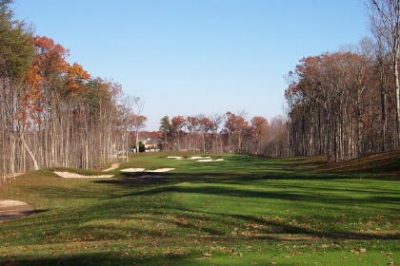 |
| Old Hickory appears to provide plenty of room off the tee. |
What is often overlooked and understated, however, is the amount of planning, coordination, knowledge and intense labor that factors into the construction of a golf course, from concept to opening day.
Zoning regulations and permit requirements were described by one official within Prince William Country's inspection department as a "complex string of events that need to come together before they even break ground." But regulations aside, specific considerations for development of the physical course range from grass types, to soil composition, to irrigation needs.
The architect plays a big role in it," said Dave Horton, superintendent of the course, employed by developers Stradinger, Swiger & Hatten LLC. "The architect has a topographical map and when he designs it, he considers the amount of dirt that might have to be moved and brought in" for both the building and final contour stages. The "best case scenario," Horton said, allows for equilibrium between the amount of dirt dug and deposited, a feat that he claimed has so far been accomplished at the present construction site.
Should unplanned movement of soil become a necessity, however, the cost can become a rapid inhibitor to maintaining bid estimates.
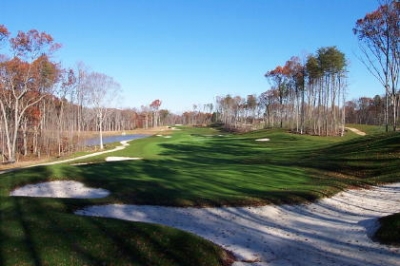 |
| Looking from behind the green, there's plenty of sand trouble to be found, even before the course opens. |
"You can miss your dirt quantities," said Kevin Harrigan, project manager for the course and a 15-year employee with the Florida-based golf course construction company, Quality Grassing. "If you have to move an extra 100,00 cubic yards of dirt, and say it's 60 cents a yard to move... that's for fuel and labor, well, you can figure it out and see" expenses can skyrocket.
It's just such specific considerations -- including the composition of the soil itself, trying to determine whether rocks are present beneath the surface and, if so, how much to budget for blasting -- that contributes to the difficulty of the bidding process.
Some golf course costs can be defrayed via additional contract provisions, as in the case of a special clause that allows for minimal profit loss should rocks be unexpectedly uncovered, but, as with many construction projects, offering a competitive bid while budgeting for expenses is often the most convoluted process.
"Staying in budget is another pitfall you have to watch out for," Horton said. "The topography of the map is not necessarily as planned. If you hit rock, that slows you down."
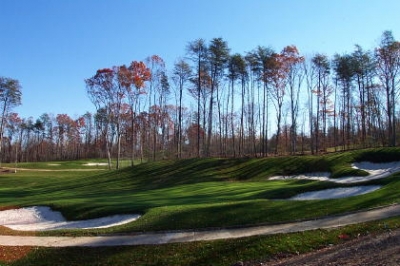 |
| Some greens look like they could be played already. |
More to the point, "If we miss something," Harrigan said, "we eat it (in terms of profits). That's the trickiest part of our job. Once we get to work, that's easier."
Getting to work on a golf course, however, entails much more than a simple deposit of grass seed and dirt. Rather, the types of each product to use are often items of intense scrutiny. Choice comes only after a slew of factors and stipulations are considered.
Bunkers, for example -- more commonly known as sand traps and once a sure source of frustration among competitive golfers everywhere -- are now filled with triangular-shaped grains, Harrigan said, so that the ball does not easily sink and play can continue at a steady pace. "That's been over the years that came about," he continued. "Yes, that was for customer demand and for the owner. The owner wants bunkers but they want you in and out of them real quick."
Selection of grass seed, however, cannot be so readily compromised solely at the discretion of customer or owner preferences. Horton, trained as an agronomist in the study of plants, soils and fertilizers, said the process of deciding which particular seed to plant in each specific area of the course is steeped in both a thorough understanding of grass growth needs and awareness of prohibitive factors.
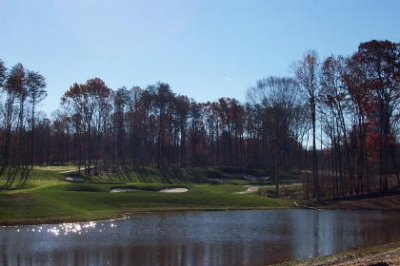 |
| Judging by this view, there's plenty of water to contend with at Old Hickory. |
Typically, grasses on the greens are maintained at heights of less than one-quarter inch while those on the fairways and tees, about a half-inch. The challenge, Horton described, is to decide not only what type of seed would thrive best under the present soil conditions, but also foresee which variety could best maintain its health into the future, regardless of what weather patterns emerge.
Bent family grass seeds -- as opposed to the more common blues or fescues -- are normally used for greens, tees and fairways. Originally procured from Afghanistan, the use of the bent family seed adds an approximate average planting cost of $100,000 per course, Horton said, but is necessary because of its ability to flourish at such short lengths and under adverse weather conditions.
Foremost for proper selection is this basic fact: The less blade surface exposed to the sun means the less energy that particular piece of grass receives, which, in turn, means the less root it can produce to strengthen and sustain itself in the event of harsh weather and disease.
"Bent is [used] when you're trying to provide grass you can cut extremely short and that can tolerate heat, cold, disease, droughts and that responds to less fertilizer," Horton said. Fescues and blue family grasses are usually reserved for the roughs, where maintenance, aesthetics and speed-of-play desires are of lesser concern.
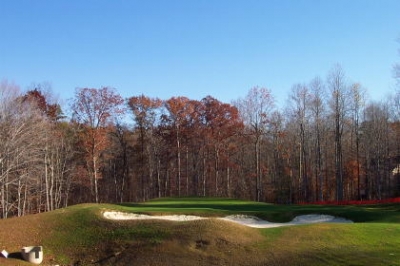 |
| Another well-bunkered green; Old Hickory is a shot-maker's course. |
Hand in hand with grass considerations are irrigation interests, as the former cannot naturally survive without a solid supply of the latter. On average, a course needs a water source capable of providing between 30 and 40 million gallons of water per year, either in the form of rainfall, well water or a pond. But, in addition, underneath each single green lies a complex and intricate system of manmade irrigation and drainage, the development for which includes an in-depth analysis of a variety of factors, including soil composition, land contours, weather patterns and expected aesthetics.
"The only time you bring in soil (from an area other than the developing course site) is for the greens, tees and bunkers because it's absolutely crucial to have the right soil," Horton said. "You have to make sure the greens don't hold the water too long. That's critical... and that's why the greens' sands are specifically sized particles."
The irrigation systems beneath each green work like sponges, Horton said, and allow for an even drain of water at minimal disturbance to the surface grass and soil. Incorporated are measured layers of sand and gravel, the particle sizes of which are crucial to maintaining the health of the course as a whole.
"It's very important the sand sand particles are the exact size so the water doesn't go right through it," Horton said, "and that the gravel particles are small enough so the sand doesn't go leaking down and... clogging up the drain."
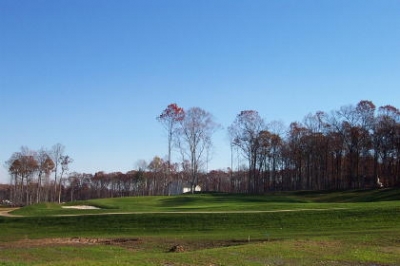 |
| There are some holes that look wide-open. |
Irrigation concerns are not restricted to the greens -- though with a price tag of tens of thousands of dollars for each putting area, they are likely of top priority. Rather, various irrigation systems wind beneath the entire course, with pipes "running all over the fairways like a spider web," Horton said, to the tune of an average $2 million.
Once the irrigation system is in place, the course begins to take shape, as the development process moves from beneath the ground to atop the surface and aesthetic considerations. "First there's clearing," Harrigan said, explaining the course construction procedure in brief. "Then, you get the plan, then there's the permits and they choose the contractor and they start the work. For the work, there's clearing, excavation, rough shaping -- that's where you actually shape the golf course but it's not fine-tuned. You still have to put the drainpipes in but the architect can see what it looks like. Then you do drainage and irrigation, the cart paths and seeding and finish shaping."
In between are the often daily inspections from county officials whose job it is to ensure all environmental and safety regulations are abided by. The on-site inspector for the present course development could not be reached for comment, but a spokesperson from the Prince William County Public Works Department provided a list of 10 areas over which the county maintains development authority, from ensuring that only pre-approved trees are removed to monitoring erosion and sediment controls.
"The county inspector can red-tag you, shut you down right then," Harrigan said, emphasizing the importance of understanding and adhering to inspection regulations.
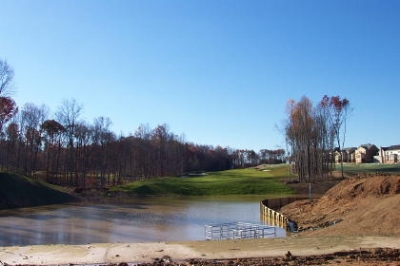 |
| There's still some work to be done before next summer's opening day. |
Vast as the physical construction of a golf course is, and particular as the planning and reaction to unforeseen events can be, an average development time still rests around 18 months. Old Hickory Golf Club, the current name for the budding 110-acre, 18 hole course -- which also includes an upscale housing project -- is slated for opening in either June or July of 2003, depending on the harshness of the winter season.
"Mostly, western Prince William County has private courses," Horton said, explaining the benefits of the club for those who live near Manassas and Manassas Park. "This one is public and Prince William County residents will probably be able to get a discount."
Details:
Old
Website: www.riverfalls.info/golf.htm
| Related Links | Comments on this article? | |
|
Maryland National Golf Club Hollow Creek Golf Club Rocky Gap Resort PB Dye Golf Club in Ijamsville Whiskey Creek Golf Club |
E-mail Jeff Rendall, Editor: jrendall@golftheunitedstates.com |











